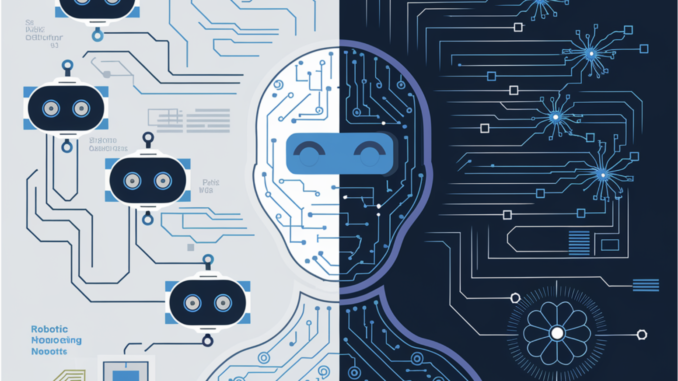
Artificial intelligence has progressed from basic rule-based mechanisms to advanced, independent entities capable of executing intricate tasks. Two terms that frequently surface in this discussion are AI Agents and Agentic AI. While they may appear synonymous, they denote distinct methodologies in creating intelligent systems. This article offers a technical evaluation of the disparities between AI Agents and Agentic AI, examining their definitions, architectures, real-life illustrations, and functions in multi-agent systems and human-AI collaboration.
Definitions and Fundamental Concepts
AI Agents: An AI agent is a self-governing software entity that perceives its surroundings, makes choices, and acts to meet specific objectives. At its essence, an AI agent adheres to a straightforward cycle: sense → decide → act. The agent acquires inputs via sensors or data streams, processes this information with decision-making logic (which may be rule-based or learned), and delivers actions through actuators or APIs. Examples range from chatbots that offer customer assistance to self-driving automobiles that interpret sensor data and navigate roads. These agents generally operate within a defined scope—humans establish their overarching goals, and the agents identify the most suitable actions within those boundaries.
Agentic AI: On the contrary, Agentic AI signifies a more contemporary paradigm where AI systems exhibit a greater level of autonomy and flexibility. An agentic AI is engineered to independently plan, carry out multi-step tasks, and continuously improve from feedback. Unlike conventional AI agents, which often adhere to a fixed or static policy, agentic AI systems can decompose intricate goals into sub-tasks, utilize external tools, and modify their strategies in real-time. For instance, an agentic AI charged with “creating a website” may autonomously generate code, design graphics, conduct tests, and deploy the site—all with minimal human oversight. While every agentic AI is a type of AI agent, not all AI agents demonstrate the dynamic, goal-driven behavior characteristic of agentic AI.
Key Technical Distinctions
Autonomy and Goal Execution
Conventional AI agents differ in their degree of autonomy. Many operate within narrow, pre-established limits and require human input for more intricate decisions. Agentic AI extends this frontier by emphasizing significant autonomy. These systems can interpret high-level objectives and formulate a series of actions to fulfill them. Rather than simply responding in one step, agentic AI consistently revises its decisions, adapting its strategy as it collects fresh data and feedback.
Adaptability and Learning
Numerous AI agents utilize a dual-phase training method: an offline training phase followed by a static deployment phase. Some agents may update their policies over time using reinforcement learning; however, this learning often remains disconnected from real-time operations. In contrast, agentic AI systems are designed for adaptability. They integrate continuous learning cycles where feedback from their environment is utilized to modify strategies in real-time. This dynamic learning capability enables agentic AI to manage unexpected developments and improve continuously without the need for explicit retraining intervals.
Decision-Making and Reasoning
Conventional AI agents generally rely on a fixed decision-making guideline or a one-step mapping from input to action. In numerous instances, they lack an explicit reasoning process that elucidates or substantiates their actions. Agentic AI systems, however, employ sophisticated reasoning techniques such as chain-of-thought planning. These systems can formulate internal narratives that decompose complex tasks into manageable subtasks, evaluate potential strategies, and choose the optimal course of action. This iterative, multi-step reasoning methodology empowers agentic AI to address complex, novel challenges with a level of adaptability that simpler agents do not possess.
Architectures and Underlying Technologies
AI Agent Architecture
At the heart of an AI agent is a cycle composed of perception, decision-making, and action. The architecture is typically modular:
Perception: Sensors or data input interfaces that collect information.
Decision Module: The “brain” of the agent that processes inputs, often utilizing rule-based systems, decision trees, or learned policies.
Actuators: Components or APIs that perform actions in the environment.
Several AI agents are developed using frameworks that facilitate reinforcement learning or rule-based decision-making. For instance, in robotics, an agent might amalgamate sensor data (from cameras or lidar), analyze it through a neural network, and control motors correspondingly.
Agentic AI Architecture
Agentic AI expands on the foundational agent architecture by incorporating various advanced components:
Cognitive Orchestrator: Often an advanced language model that interprets objectives, reasons about tasks, and organizes a sequence of actions.
Dynamic Tool Use: The agent can independently invoke external tools or APIs (e.g., databases, search engines, code interpreters) as part of its problem-solving approach.
Memory and Context: Unlike basic agents, agentic systems retain a memory of prior interactions, allowing them to reference past data and enhance consistency over extensive tasks.
Planning and Meta-Reasoning: Agentic AI can formulate multi-step plans and modify them in real-time if circumstances change, frequently utilizing techniques originating from chain-of-thought reasoning.
Multi-Agent Orchestration: Some agentic systems are constructed to generate or collaborate with other specialized sub-agents, thus distributing tasks and boosting efficiency.
Developers are employing frameworks like LangChain and Semantic Kernel to create these sophisticated systems, merging the advantages of large language models, reinforcement learning, and tool integration.
Real-World Applications
Robotics and Autonomous Vehicles
In the domain of robotics, conventional AI agents are observed in systems like robotic vacuum cleaners or warehouse robots. These agents adhere to a set of established rules to navigate and accomplish tasks. Nonetheless, agentic AI systems advance robotics by enabling robots to adjust to shifting environments in real-time. Consider a self-driving vehicle that not only obeys traffic regulations but also learns from its surroundings—modifying to road conditions, recalibrating routes when unanticipated obstacles emerge, and even collaborating with other vehicles. This degree of autonomy and flexibility is a clear illustration of agentic AI.
Finance and Trading
In the financial sector, AI agents are employed for algorithmic trading. A trading bot may carry out transactions based on pre-established signals or patterns in market data. An agentic AI trading system, however, can autonomously modify its strategy based on real-time news, economic indicators, or even social media sentiments. By constantly learning and adjusting its policy, an agentic trading agent can optimize portfolio management and risk assessment in a manner significantly more dynamic than its traditional counterparts.
Healthcare
Traditional AI agents in healthcare involve virtual assistants that manage patient inquiries or track vital signs. Agentic AI systems,
however, possess the capability to transform personalized healthcare. For instance, an autonomous healthcare AI could oversee a patient’s treatment regimen by continuously tracking health metrics from wearable gadgets, modifying medication levels, arranging assessments, and notifying healthcare providers if irregularities arise. This type of system not only streamlines routine duties but also adapts based on patient data to offer increasingly tailored care.
Software Development and IT Operations
Within software development, AI agents such as coding assistants (e.g., GitHub Copilot) provide instantaneous coding suggestions. An autonomous AI could advance this capability by independently creating entire codebases from high-level outlines, troubleshooting problems, and deploying software applications. In IT operations, autonomous AI agents can observe system metrics, identify irregularities, and proactively execute corrective measures like scaling resources or reverting faulty deployments. This anticipatory method boosts system dependability and diminishes downtime.
Multi-Agent Systems and Human-AI Collaboration
Multi-Agent Systems
In multi-agent systems, numerous AI agents collaborate—each fulfilling a specific function—to tackle complicated tasks. Conventional multi-agent systems have rigid roles and communication frameworks. Conversely, autonomous AI systems can flexibly create and coordinate multiple sub-agents, with each addressing a portion of a broader task. This dynamic coordination facilitates a more adaptable, responsive, and scalable method to problem-solving, allowing rapid adjustments to complex environments.
Human-AI Collaboration
Historically, AI agents have been recognized as instruments that execute assignments upon request. Autonomous AI, in contrast, positions itself as an engaging partner capable of independent decision-making while remaining under human supervision. In a corporate environment, for example, an autonomous AI could manage routine operational activities—such as scheduling, data assessment, and reporting—permitting human managers to concentrate on strategic decision-making. The AI’s capacity to articulate its reasoning and adjust based on input further cultivates trust and practicality in collaborative settings.
Conclusion
Although both AI agents and autonomous AI share the fundamental principle of independent systems, their distinctions are noteworthy. AI agents typically perform predetermined tasks within a limited framework, frequently lacking profound real-time learning or multi-step reasoning. Autonomous AI, on the other hand, is designed for substantial autonomy, flexibility, and intricate problem resolution. With architectures that integrate dynamic tool utilization, memory, and sophisticated reasoning, autonomous AI systems are set to transform various sectors—from self-driving cars and finance to healthcare and software development.
Sana Hassan, a consulting intern at Marktechpost and dual-degree student at IIT Madras, is enthusiastic about utilizing technology and AI to tackle real-world issues. With a strong interest in addressing practical challenges, he offers a fresh viewpoint at the convergence of AI and tangible solutions.








1 Trackback / Pingback